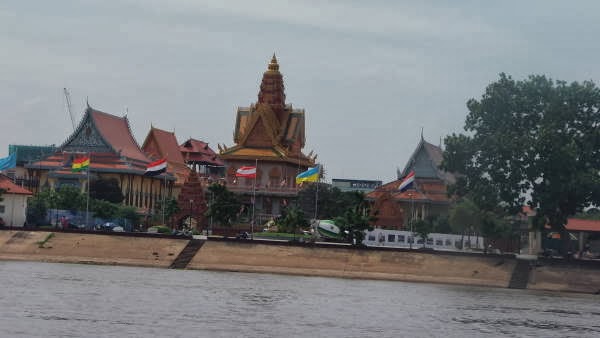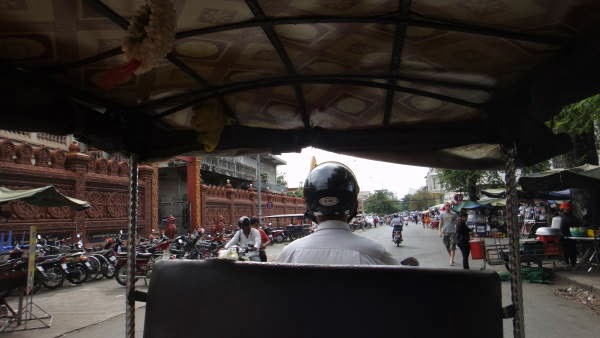22.-23.11.2013
On 22 November we travelled from Phnom Penh to Siem Riep.
Below: the capital of Cambodia before the city was moved to its present location in 1434.
Am 22.11. fuhren wir von Phnom Penh nach Siem Riep.
Am Weg- Oudong: Kambodschas Hauptstadt vor Phnom Penh.
Palm trees growing in rice fields
Palmen und Reisfelder
Typical dwellings are built on stilts, often with brightly-painted steps to the door.
Typisches kambodschanisches Stelzenhaus: unten Werkzeug und Tiere - darüber leben die Meschen- im Dach die Geister der Ahnen.
Arrival in Angkor Wat - water lilies on the moat surrounding the complex.
Ankunft in Angkor Wat- Seerosen im Wassergraben.
Approaching Angkor Wat from the east - remains of an outside wall. Angkor Wat means "Town which is a Temple."
Osttor der äußeren Mauer
Angkor Wat was constructed in the early 12th century when Angkor was the capital of the Khmer Empire. Below: East entrance - contrary to Khmer temples which faced east, Angkor Wat was built facing west.
Angkor Wat (Angkor=Stadt, Wat=Kloster) wurde im 12.Jhdt nahe der damaligen Hauptstadt Angkor erbaut (siehe Wiki: Angkor)
Osteingang in Tempelanlage.
Stepes leading to the south entrance of the first level - the temple is built on three levels.
Treppe mit Nagas führt zum Südeingang der 1. Ebene.
Remains of one of two libraries inside on the first (ground) level.
Bibliothek (1. Ebene)
Above and below: Views of the temple's outer wall from inside the first level. The temple was constructed like a pyramid with three rectangular galleries rising to a central tower, each level higher than the last.
Mauer der 2. Ebene
Steep steps lead to the third level. After our experiences with Inca steps however, we were not at all daunted by this easier version.
Blick vom Eingang zur 2.Ebene auf steile Treppe zur 3.
View of one of the four corner towers from the second level - the temple's five towers are on the third and highest level.
Blick auf den Südostturm der 3. Ebene- Angkor Wat hat fünf Türme- der mittlere, höchste symbolisiert den heiligen Berg Meru.
The main, central sanctuary of the temple on the third (top) level
Zentralturm
Originally built as a Hindu temple, dedicated to the god Vishnu, Angkor Wat gradually became a Buddhist temple. Images of both religions are represented in the complex.
Ursprünglich hinduistisch wurde später auch Buddha verehrt.
View from the third level looking down over the temple buildings.
Blick von 3.Ebene (weit im Hintergrund das West Tor)
Gangway inside the upper level - one of the four corner towers.
Eckturm (3.Ebene)
Apsaras, half-divine, half-human dancing girls, are characters from Indian mythology, and many bas-reliefs can be found adorning the the upper walls of Ankgor Wat.
Apsaras- halb menschliche, halb göttliche Tänzerinnen.
Galerie (3.Ebene)
The inner walls of the first level bear a series of large-scale scenes mainly depicting episodes from the Hindu epics the Ramayama and the Mahabharata.
Wieder in der 1. Ebene- Darstellungen der hinduistischen Epen Ramayama und Mahabharata.
Looking back on our way to the West, or main entrance.
Für den Film "Tomb Raider" wurde hier ein künstlicher See mit Dorf angelegt.
The main entrance has five doors; the central one for the king, to the right and left less grandiose doorways for the people, and two further doors, one at each corner of the west gallery for the elephants. We are using the royal exit. The sweepers are hard at work with colourful broomsticks.
West Tor von innen- Haupteingang für den König- daneben für das Volk...
One of the peoples' entrances, to the right of the picture an elephant door.
....Eingang für das Volk...im Hintergrund Eingang für
die Elefanten.
A restored causeway leads from the main entrance back across the moat.
Teilrestaurierte Brücke führt zum West Tor.












































































